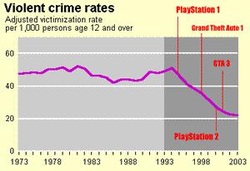Opinion on Video Game Violence

Video Games are a little too graphic and influential for kids and youths in a negative way. I don’t think that violent video games cause anybody to kill anybody else. It seems that video games are being used as a scapegoat to things that people cannot explain, columnist Duke Ferris said it best on his article “Caution: Children Playing The Truth About Violent Youth and Video Games”, Ferris states “Don't forget that in the 1950's, rock and roll was linked to youth violence in the same way”. Blaming video games for reasons that are obscure is ridiculous. Ferris also did his own research on he matter of violent crimes. This graph chart was inserted in the same article he wrote. “For effect, I've also marked the release of the PlayStation console, the first Grand Theft Auto game, the PS2console, and the infamous GTA 3. Wow, look at those surges in violence!” He then goes on to say that he did get the graph from U.S. Department of Justice, Bureau of Statistics.
I do agree that it makes players more aggressive, but not to the extent of killing anybody. This problem has been addressed by implementing the ESRB (Entertainment Software Rating Board ) rating system that determines the age appropriate games a certain youth can play.
I do agree that it makes players more aggressive, but not to the extent of killing anybody. This problem has been addressed by implementing the ESRB (Entertainment Software Rating Board ) rating system that determines the age appropriate games a certain youth can play.

www.esrb.org
As a gamer myself I do see video game vendors ask the purchaser for their age but don’t ask for proof. An additional policy that needs to applied would be that proof. Just like when someone is purchasing alcohol and/or cigarettes they ask for ID to swipe for the system to get the birth date information. I know that in cases like that loop hole would be just inputting Date of birth manually, but not with this system it would require the card to be swiped. This ID would not be a State Issued ID/drivers license, but a specific license for purchasing games that fit the ESRB rating age and the ESRB would distribute. They would issue a quick test that players can prove they know the difference form right and wrong. The reason for this is because it’s to easy for a kid to buy a non-appropriate age game for them selves. My self as a teenager, I found it too easy to buy an M rated game. They denied me the purchase of the game, but my mother was there to buy for me she did not know anything about the rating system. But she knows me she knows I was not a violent kid I never got in to serious trouble at school for fighting or anything like that. She knew I was not going to let a video game influence me like that. Which brings me to my next point, second part of my proposed policy.
As many people are stating and I believe it’s true that people should be able to determine the difference of what’s real and what’s not, common sense, and yes it is that many people don’t have common sense. At that point it should be parents responsibility to educated and explain the difference between what’s acceptable and what to do in today’s society. Benjamin Radford wrote about no proof given yet that video games harm teens, in part of his article he writes "Daily teen life involves some profanity, adult themes . . . Has the sexual material resulted in an increase in teen sex? No". Radford uses National Center for Health Statistics report that there is a decrease in teens having sex, even if there exposed to sexual content. This implies that same effect is for violent video games; just cause teens are exposed to the media does not mean they will be affected by it and teens then will be violent and/or aggressive. Its just innocent fun that helps relief stress, as college student I play video games to relive the stress of getting good grades to keep getting financial aid. In the end the I know the difference between the video game world and the real world.
Referneces
Ferris, Duke. (2005, August 8). Caution: Children at Play The Truth About Violent
Youth and Video Games [Web Log Comment] Retrieved from
http://www.gamerevolution.com/features/violence_and_videogames
Radford, B (2005) Violent Video Games Have not Been Proven to Harm Teens,retrieved from www.livescience.com
